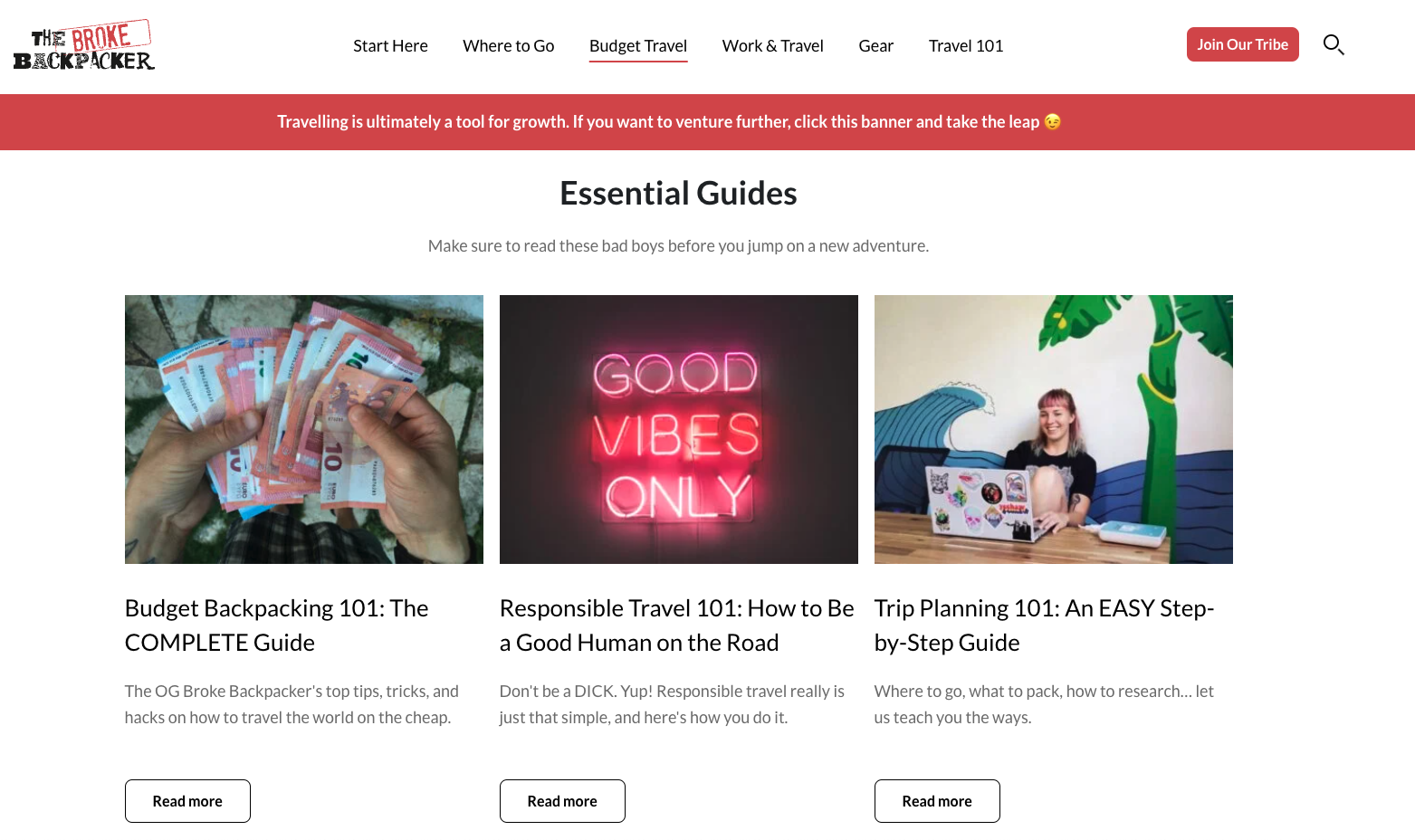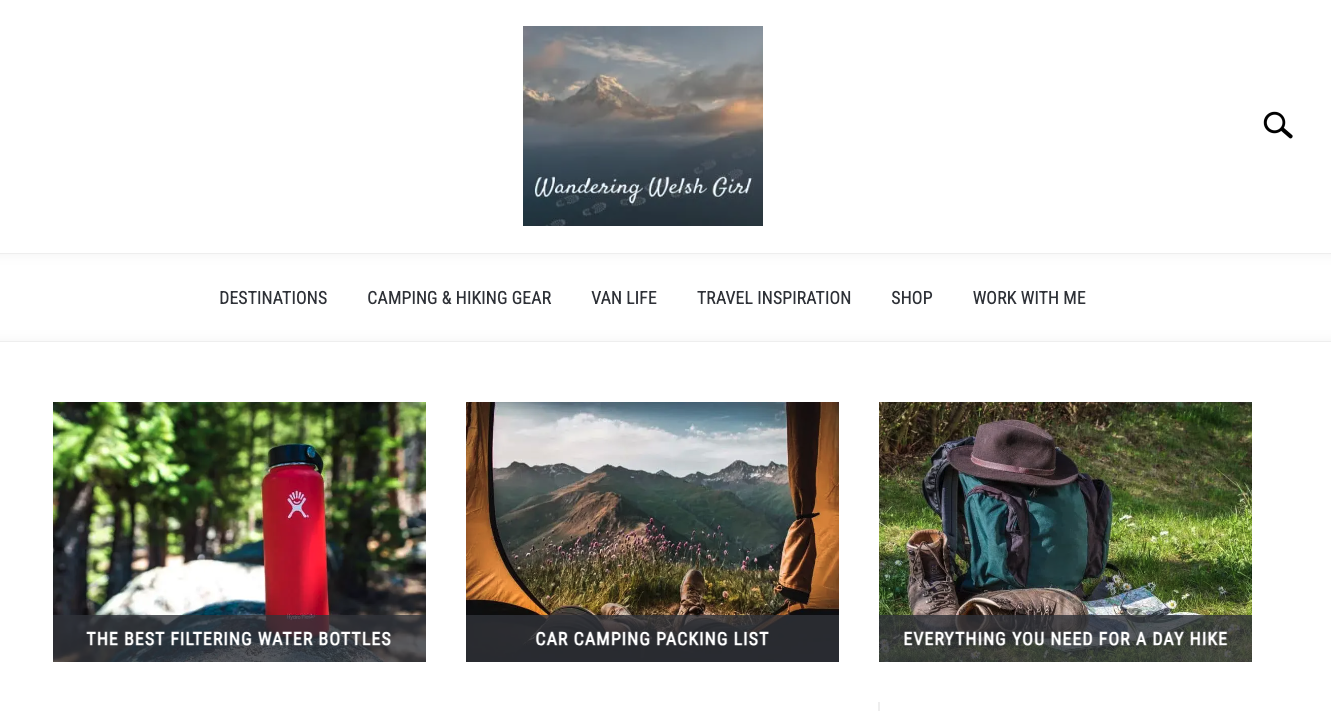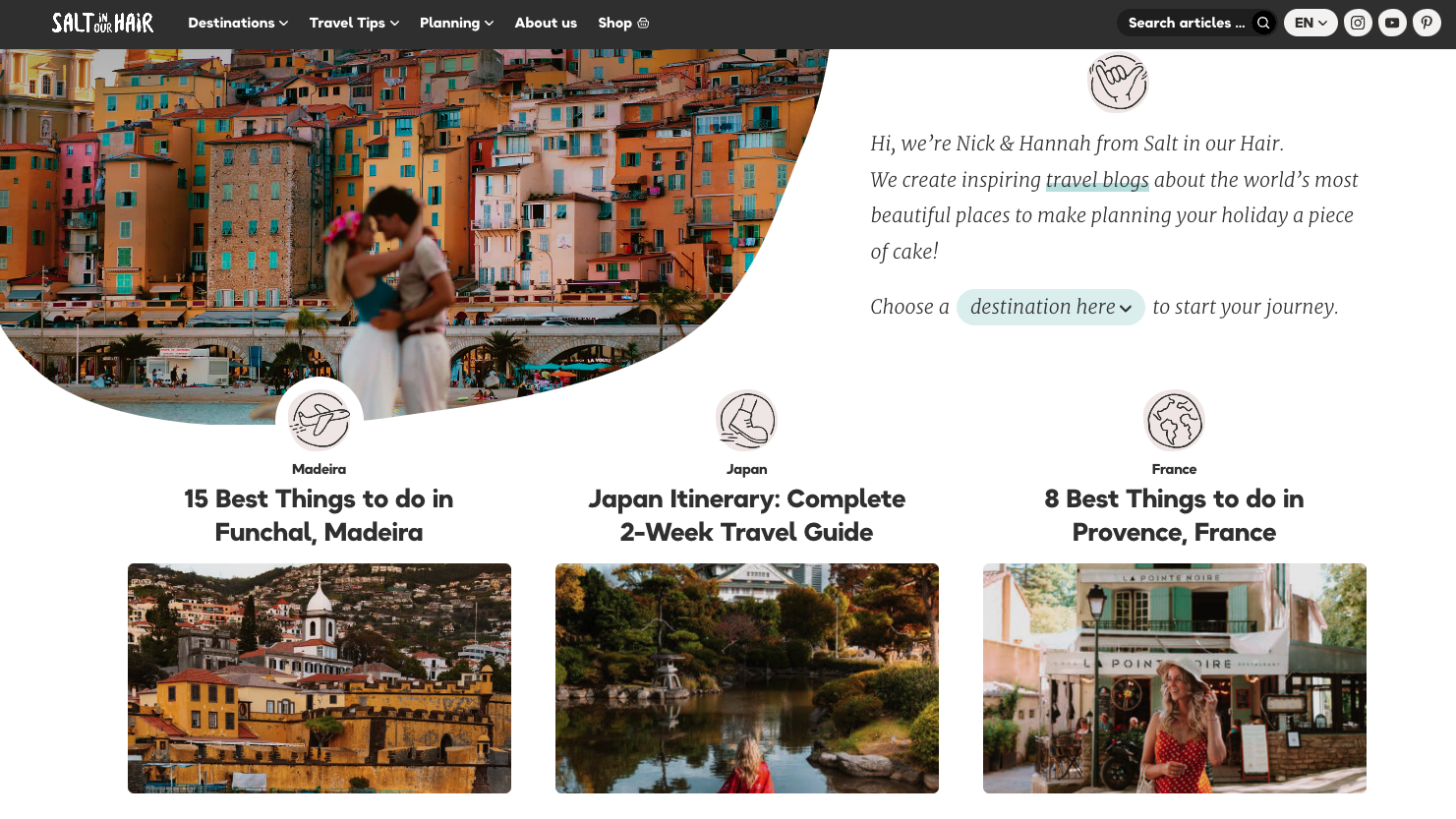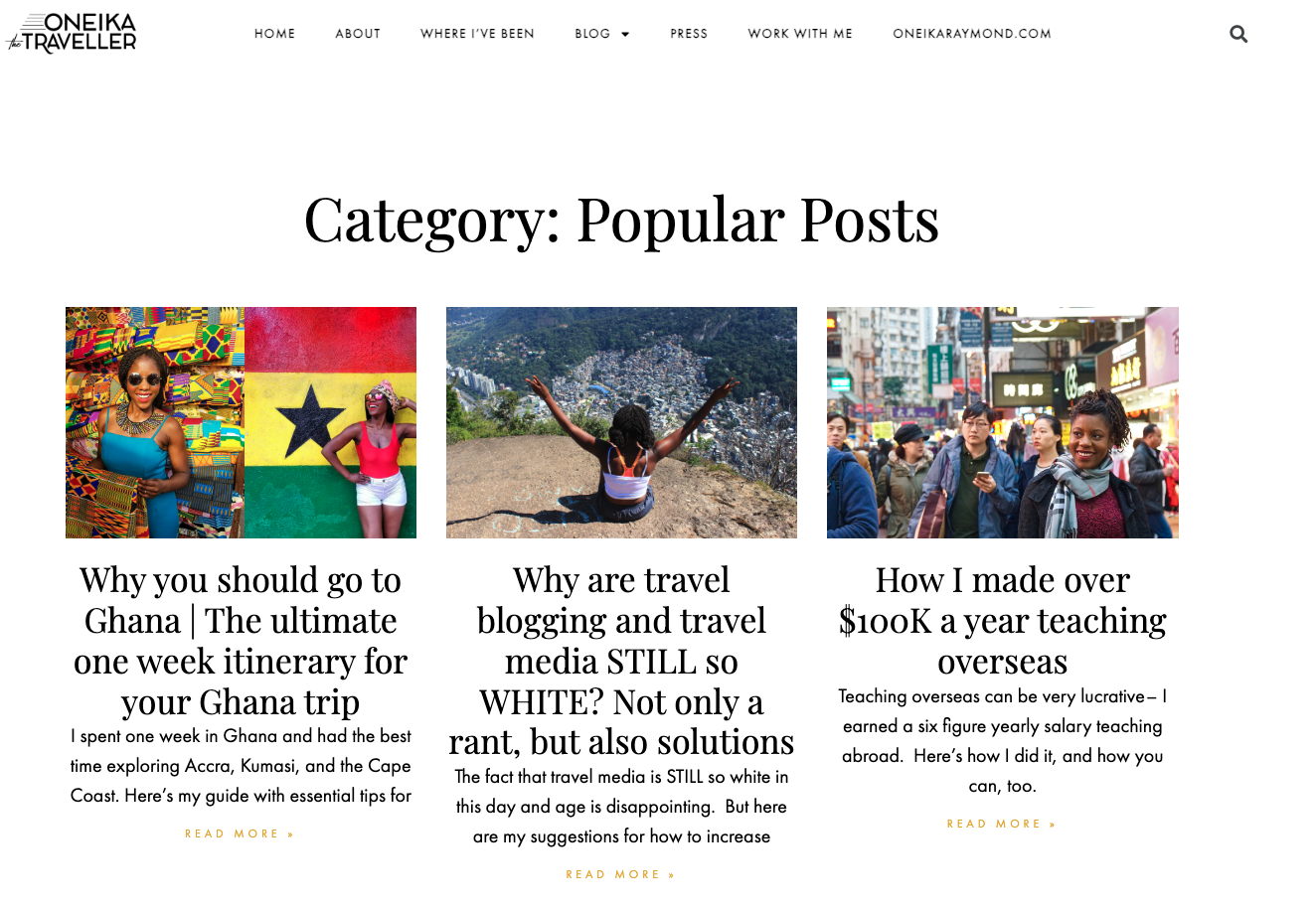
How to Write a Travel Blog
Do you know how to write a travel blog? If not, would you like to learn? Being able to turn your travel experiences into captivating stories that effectively convey the sights, sounds, and emotions of globetrotting is a valuable skill. It can also be lucrative, as many publications pay travel writers to share their experiences and perspectives.
In this blog post, we’re going to:
- Tell you what a travel blog is
- Share 11 compelling reasons why you might want to start a travel blog
- Explain how to structure and write a travel blog that stands out from the crowd
- Showcase five inspiring travel blogs
- Offer you an opportunity to gain the skills you need to craft an outstanding travel blog
Read on to find out everything you need to know to get started as a travel blogger!
What Is a Travel Blog?
A blog (short for weblog) is a journal-style website that contains regularly updated information. It can be run by an individual, group, business, or organization. The posts are normally presented with the most recent first, followed by the older ones in reverse chronological order. They are generally written in an informal style with the intention of educating, presenting products or reviews, sharing news, or providing some form of commentary to blog’s target audience.
A travel blog is simply a blog whose primary subject matter is, unsurprisingly, travel! Travel blogs provide a medium for people to share adventures, experiences, idyllic destinations, local points of interest, travel tips, and other travel-related information. They can act as an inspiration to aspiring travelers and happen to be one of the best blogging niches for freelance writers.
Why Write a Travel Blog?
You may be wondering, why write a travel blog? Isn’t the experience of traveling valuable enough in and of itself? While that may be true, there are many valid reasons for writing a travel blog.
Whether you want a personal record of your travels, an outlet for your creativity, a chance to meet like-minded people, or a means of making a little extra money, writing a travel blog can be a very rewarding exercise. There are a lot of good reasons for writing about your experience, so let’s look at what writing a travel blog can do for you.
1. Record Your Memories
When you’re in the midst of enjoying an amazing trip, you might think you’ll remember every detail of what you’ve seen, done, felt, tasted, and so on. Unfortunately, this isn’t usually the case. You may be surprised at how many things get forgotten once the adventure ends and you’re back in a familiar setting.
For this reason, a lot of people like to keep a daily journal while they’re traveling, and writing a travel blog is just another way of doing that. Writing about your experiences will help you remember every detail. Each blog post might represent just one destination, event, or period of time, but keep writing and you’ll be forming a narrative of your travels as a whole. After a while, it can become a permanent record that you can refer back to whenever you want to relive your experiences.
2. Keep Your Loved Ones Updated
A detailed written record of your travels is also something you can share with your friends and family. When you’re writing, a piece of yourself will shine through in your words, something your loved ones will appreciate.
If you’re taking a longer trip, a travel blog can be a good way to keep people updated while you’re away. Your friends back home can share in your journey and stay connected to what you are doing. Plus, writing a travel blog is a lot easier than sending individual emails to everyone you know!
3. Develop a Creative Outlet
With a travel blog, you have full creative control over the style and content. You don’t have to be a professional writer or lifelong traveler – the process of creating your travel blog can be rewarding on its own. Just like painting, writing poetry, or making music, participating in any kind of creative activity gives you a break from the routine of daily life. And it can be a great way to reduce stress.
4. Discover a Therapeutic Opportunity
For many, blogging is a therapeutic process. If your journey occasionally makes you feel overwhelmed, bored, depressed, or anxious, it can be helpful to take a break, find a peaceful setting, and write about your travels. Reflecting on your travels through writing can help you process your experiences, manage feelings of homesickness or culture shock, and unlock a deeper understanding of the places you’ve visited – and of yourself.
5. Connect With Others
Sharing your personal stories is a great way to connect not only with your friends, family, and other readers but also with like-minded bloggers. Interacting with other travel bloggers can be a source of inspiration for your own work. And as your network and audience grow, you can experience a sense of accomplishment, knowing that people enjoy your writing.
6. Encourage Yourself to Travel More
If you love traveling, you probably don’t need much encouragement to pack up and set off on another adventure. But if you’re hesitant, knowing you’ll be able to write a few more blog posts could be the extra incentive you need to pursue the life of a digital nomad.
Plus, more trips mean fresh material – and fresh material means more exciting posts. As you gain readers, you’ll feel even more inspired to venture out, discover new places, and write about them.
7. Combat Laziness
This may only apply to a few people, but writing a travel blog can also prompt you to do more along the road. While most of us need some downtime when traveling, you might not want to be relaxing on a beach the whole time. Thinking about your next blog post could motivate you to explore more places, take risks, join tours, or eat at restaurants that you might otherwise ignore.
8. Devise Alternative Travel Itineraries
Have you ever gone somewhere and had no idea what to do? Have you felt that many websites and travel guides recommend the same places to visit? Maybe the standard travel routes are filled with destinations or activities that you find boring.
Through writing your travel blog, you can develop itineraries that are specifically tailored to your needs and interests. This is your chance to explore lesser-known destinations, to pull out the map and see what lies down the road less traveled. Many of your readers are likely to find them attractive as well.
9. Support Places You Love
Having your own travel blog allows you to showcase any destination, accommodation, restaurant, festival, or local event that you think is special. This is particularly true if you’ve decided to create your own unique travel itineraries.
Drawing attention to the business or events you’ve enjoyed while traveling can encourage others to try them as well. By bringing more awareness to these places and experiences, you’ll help the businesses and organizations thrive, ensuring their success so you (and everyone else) can continue to enjoy them in the future.
10. Develop Another Income Stream
This benefit is often overlooked by new travel bloggers. You could start a blog for free and make money, but if you love to travel and write, there’s no reason why you can’t earn a little extra money doing just that.
Affiliate marketing, displaying advertisements, and writing product reviews are just a few ways you can monetize your blog. You can choose to do as much or as little of these as you want, depending on the style of your blog and how much money you want to make from it.
11. Open Up New Opportunities
Even if you don’t want to make money directly from your blog, other opportunities might present themselves. You have no idea who might be reading your posts and enjoying them. This can make your name stand out, so you become recognized for your knowledge and expertise in that aspect of traveling that got you out on the road in the first place.
If you’ve dreamed about becoming a freelance travel writer, developing a successful travel blog could be the competitive edge you need to excel in that exciting career.
How to Write a Travel Blog
Now that you know why travel blogging can be so valuable, let’s explore how to create a blog that stands out. Here’s a step-by-step approach to get you started:
1. Research
Start by looking at some other travel blogs. Go online and find some of the most popular and longest-running blogs and pay attention to how they’re written and formatted. Note common themes and what’s missing or hasn’t been written about. By doing thorough research, you can figure out what makes a travel blog successful and get inspiration for your own at the same time.
Certain details to look out for when analyzing other blogs include:
- Writing style
- Titles, headings, and subheadings
- Overall page layout
- General content
- Use of images and videos
- Presence of a call to action
2. Brainstorm
The next step in blog creation is deciding what you are going to write about. While travel blogging in itself is a niche, there are lots of ways to write about the subject of travel. You should aim to specialize further by choosing topics that relate to your passions, knowledge, or experiences. Here are some things to consider:
- Who? Think about your target audience. Are you writing for young backpackers looking for adventure or retirees looking for a comfortable vacation? Solo travelers, or family groups?
- What? What draws you to travel? What makes you most excited? Is it a specific activity such as hiking or is it the people you meet or perhaps quiet afternoons in coffee shops?
- Where? Are you a world traveler, or are you going to focus on the intimate knowledge you have about a specific place?
- How? Consider your blog format. Are you going to write listicles, guides, reviews, interviews, or travel tips?
3. Create a Content Calendar
Once you’ve decided what you want to write about, you can create a list of ideas. The content should be original and different from what has already been published. Consider what topics or aspects of travel or a place are most frequently mentioned. What do you enjoy that hasn’t been talked about much? If you want to write about a topic that has already been covered, try to present a new angle or perspective.
When you start your blog, posting on a regular basis will ensure your readers stay interested and grow in number. After you’ve come up with your list of ideas, create a content calendar to keep track of when you’ll publish each post.
4. Conduct Keyword Research
Keywords are terms that will help your blog rank highly in search engine results pages (SERPs). Before you start writing your post, make sure you know what keywords are and how to use them.
Keywords can be used in different ways, and knowing how to set keywords will increase your ranking in SERPs and help your blog to be seen by as many interested readers as possible.
5. Prepare an Outline
Once you know the kind of blog you’re going to create, what you’re going to write about, and the relevant keywords, you can prepare an outline – this will help you structure your first, and subsequent, posts for a consistent format. Here’s what to include in a thorough outline:
- Overview of the blog’s main points
- Organization of headings and subheadings
- Structure of the post, including the introduction, main body of text, and conclusion
6. Start Writing
It’s finally time to put pen to paper (or fingers to the keyboard). Remember that you want your blog to be unique, so follow your outline but let your personal tone and style shine through. Sometimes the thinking process really gets started once you begin writing. So don’t try to craft everything as a finished product before you start, get words down, then let the ideas start flowing.
7. Proofread and Edit
Before you publish your post, you need to make sure it’s free from errors. You don’t want people to bypass your great experiences because they tripped over typos and poorly written sentences. After writing, take a short break and let your subconscious mind contemplate what you’ve created. You can then return to your post with a refreshed set of eyes and see if it can be improved. Check it over for any inconsistencies or mistakes in spelling, punctuation, and grammar.
Top Tips for the Perfect Travel Blog Post
As mentioned above, travel writing is a popular niche, which means there are a lot of travel blogs out there. Here are a few tips to make yours stand out from the rest!
Network With Other Travelers
Networking is always a great way to meet like-minded people to share ideas, get inspiration, and grow your audience. Here are some key steps to start networking as a travel blog writer:
- Join an online travel community like Travel is Life.
- Increase your presence in social media groups – share your own posts and share and interact with other people’s posts.
- Include a comments section on your blog and be active in it. Seek out other forums and engage with those as well.
Incorporate Multimedia
It’s often said that a picture is worth a thousand words. While we can’t be sure of that precise word count, including high-quality pictures and videos in your blog can be a great way to make your posts come alive.
Seek Out Experts
If you have the opportunity to include interviews or testimonials in your travel blog posts, take it! Intriguing residents, business owners, and local celebrities are all great candidates. Don’t miss out on the chance to talk to them and paint a more personal account of any destination.
Develop an Engaging Style
You want your readers to enjoy your blog and keep coming back for more. To do this, make sure you cultivate a writing style that draws people back. Here are some tips for keeping your posts interesting:
- Approach your topics from a unique and authentic viewpoint to keep them both informative and engaging.
- Be detailed and descriptive and narrow the focus of your posts.
- Include more than one viewpoint on a topic.
- Use humor to lighten the mood.
- Offer helpful information or links to relevant courses, products, resources, and so on.
- Share a controversial opinion or unusual perspective to generate hype.
5 Inspiring Travel Blog Examples
Now that you know how to create a successful travel blog, it’s time to start your research. Check out some of these fascinating travel blogs to get some inspiration.
1. Nomadic Matt
Claiming to be one of the first true travel bloggers, Matt has been featured in the New York Times. His blog focuses on budget travel tips and guides.

2. The Broke Backpacker
This is another budget travel blog that shows what eye-catching sites can be created with WordPress.

3. Wandering Welsh Girl
This blog is dedicated to off-the-beaten-path destinations and offers travel itineraries, destination and hiking guides, and product reviews.

4. Salt in Our Hair
Run by an adventurous couple, this blog tries to inspire others to travel sustainably.

5. Oneika the Traveller
The author of this blog shares her unique perspective as a black, female solo traveler. She’s also a TV host and Emmy award-winning journalist.

Becoming A Content Writer
If you want to write an amazing travel blog of your own but feel you may be lacking some of the skills required to be a great blog writer, don’t worry. We have a course that can teach you what you need to know to get started!
Becoming A Freelance Writer will show you how to research, prepare, write, and redraft compelling blog posts. Plus, achieve 80% or more in the final assignment, and you’ll have the opportunity to gain experience by writing three pieces of content for our blog.
Updated on March 25, 2025





Your email address will not be published.